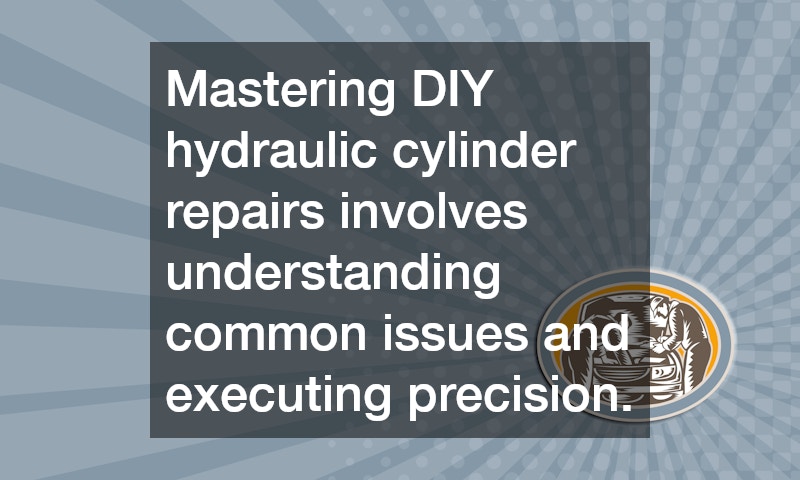Delving into the world of DIY hydraulic cylinder repair requires a solid understanding of essential precautions and methodologies. Proper safety measures are indispensable, such as wearing protective gear and ensuring the machinery is safely deactivated. Having the right tools like wrenches, seal kits, and measuring instruments will streamline the repair process and prevent further damage to the components.
How to Identify Common Hydraulic Cylinder Issues?
1. Recognizing Symptoms of Cylinder Wear and Tear
Spotting early signs of wear in a hydraulic cylinder such as fluid leaks, slow operation, and unusual noises can prevent major breakdowns. Leaks may appear as wet spots or a drop in hydraulic fluid levels, indicating a potential seal failure. Slow operation could result from internal leakage, necessitating a thorough evaluation of seals and piston condition.
Unusual noises often signify air entrapment or damaged seals, each of which demands prompt attention. Identifying these symptoms early allows for timely intervention, reducing expensive downtime. Regular inspections should be conducted to detect these indicators and address them before they escalate.
2. Diagnosing Hydraulic System Failures
Diagnosing failures within a hydraulic system requires a systematic approach to pinpoint the issue accurately. Start by checking for external leaks in hoses and fittings that might compromise pressure levels. Internal leaks, often harder to identify, occur when pressurized fluid bypass seals within the cylinder or control valves.
Evaluate pressure gauges to determine inconsistencies that could indicate malfunctioning components. The presence of foam in hydraulic fluid might reveal air contamination, necessitating venting procedures to restore normal operation. A clear understanding of these common failure points will aid in targeted troubleshooting.
3. Understanding the Role of Maintenance
Regular maintenance acts as a preventive measure to ensure the hydraulic system operates at optimal efficiency. Implement a maintenance schedule that includes periodic fluid checks and changes, as this will avert contamination issues. Keeping a record of maintenance activities helps in tracking wear patterns and the timely replacement of parts.
Routine inspections allow operators to anticipate mechanical failures before they manifest into major repairs. Clean components regularly to prevent dirt accumulation, which can severely degrade performance over time. Emphasizing maintenance cultivates longevity and reduces the likelihood of unexpected downtimes.
What is the Step-by-Step Process for Repairing a Hydraulic Cylinder?
1. Disassembling the Cylinder
Before disassembling a hydraulic cylinder, ensure that it is safely disconnected from the machinery and depressurized. Use appropriate tools to remove any protective covers or fittings, paying close attention to their condition for future reference. Carefully document each part’s position and orientation to facilitate a seamless reassembly process.
Gently extract the piston rod assembly, taking care not to damage the surfaces or seals during removal. Inspect the cylinder tube for any scoring or rust, which can affect the sealing capability and pressure integrity. Maintaining a clean workspace will prevent contamination of the components during disassembly.
2. Evaluating and Replacing Worn Parts
Once disassembled, examine each component for signs of wear or damage, focusing on seals, bearings, and rods. Seals should be free from cracks, and rods should be perfectly straight without scratch marks, indicative of wear. Bearings should rotate smoothly without excess play, pointing to their health.
If damage is found, source replacement parts compatible with the hydraulic cylinder specifications. Use calipers and micrometers to ensure precise measurements, as this is crucial in maintaining correct tolerances and operation. Replacing faulty components prevents recurrence of failures and enhances the longevity of the system.
3. Reassembling the Cylinder
Begin reassembly by thoroughly cleaning each component to remove any contaminants that might have settled during the repair process. Reinstall the piston and seals, ensuring they are correctly seated to avoid premature failures or leaks. Pay close attention to torque specifications when securing fittings and fasteners.
Refill the system with fresh hydraulic fluid, purging any trapped air to restore full operational capacity. Conduct a series of tests to ensure the cylinder performs seamlessly under load without leaks. Testing guarantees the efficacy of repairs and confirms that the components meet functional standards.
In conclusion, mastering DIY hydraulic cylinder repairs involves understanding common issues, executing precise repairs, and valuing consistent maintenance. By adhering to a structured approach and regularly maintaining the hydraulic system, one can prevent significant malfunctions and enhance overall longevity. Attentive operation and proactive measures are paramount to safeguarding the functionality and efficiency of hydraulic components.
.
